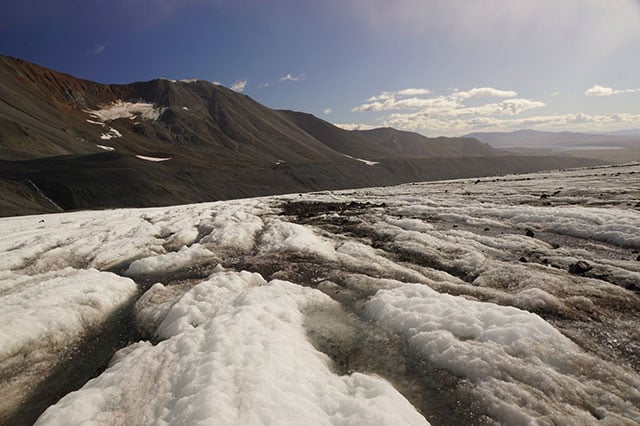
Part of the Series
Climate Disruption Dispatches
Planet or Profit
Honest, paywall-free news is rare. Please support our boldly independent journalism with a donation of any size.
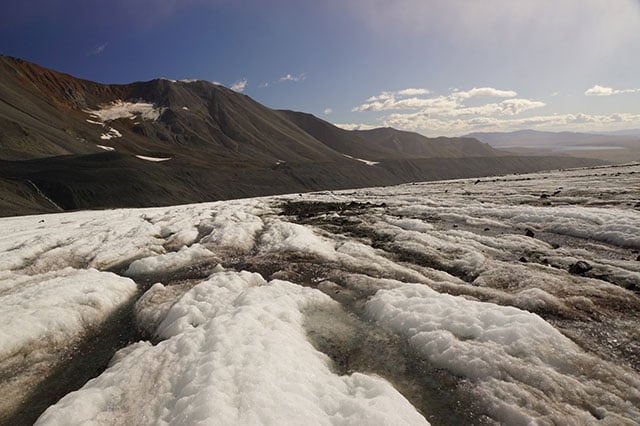 The Gulkana Glacier in the Eastern Alaska Range is melting and retreating rapidly. US Geological Survey glaciologists told Truthout they expect this year to be among the top three highest-melt years for the glacier, which has been studied every year for the last 60 years. (Photo: Dahr Jamail)
The Gulkana Glacier in the Eastern Alaska Range is melting and retreating rapidly. US Geological Survey glaciologists told Truthout they expect this year to be among the top three highest-melt years for the glacier, which has been studied every year for the last 60 years. (Photo: Dahr Jamail)
It is August 30. I’m in Anchorage, Alaska, and it’s hot. Very hot. In fact, it’s the fourth straight day of record high temperatures, amidst a year that has seen record high temperatures becoming normalized across the entire state.
Two days ago, this city (the most populous in Alaska) saw a record high temperature of 78 degrees, which beat the previous record by a whopping seven degrees.
Last night, I returned here from a trip with the US Geological Survey (USGS), during which we measured the Gulkana Glacier in the Eastern Alaska Range. Almost needless to say, the glacier, like thousands across this northernmost state, is melting rapidly and is in full retreat.
To see more stories like this, visit “Planet or Profit?”
I asked one of the USGS researchers studying this glacier to share his feelings about what is happening to the glaciers in his home state of Alaska.
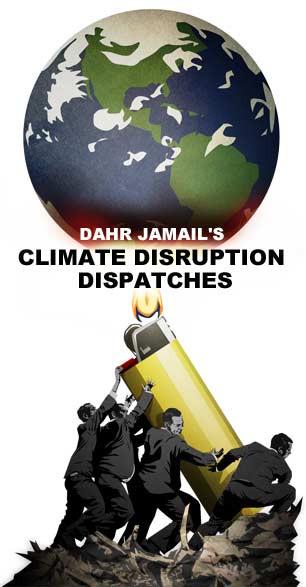 “You see stuff and it’s hard to believe it sometimes,” Shad O’Neel, a USGS research geophysicist says as we sit talking in a meeting room at the USGS office complex in Anchorage. “The scale that is happening, like hiking into Gulkana [Glacier], the stream you follow up to it, it branches into two before you get to the glacier.”
“You see stuff and it’s hard to believe it sometimes,” Shad O’Neel, a USGS research geophysicist says as we sit talking in a meeting room at the USGS office complex in Anchorage. “The scale that is happening, like hiking into Gulkana [Glacier], the stream you follow up to it, it branches into two before you get to the glacier.”
As we talk, we are both cognizant of the fact that it is warming rapidly outside, and the forecast is for more of the same.
“When I was in grad school, the terminus of the glacier was at that river branch, which is now one kilometer from the terminus,” he says. “Last year I was there, and I realized it wasn’t that long ago I was in school, and now look at how much ice is just gone. It’s a lot of ice. It’s hard for me to wrap my head around how fast it has been happening just in the past few years.”
He pauses, then says, “There was a while when it was warmer but the glaciers hadn’t quite responded yet, but now we’re really seeing the change in them, and it’s accelerating.”
It has been amazing and disturbing to be in Alaska for much of the summer as one record after another is broken. The contrast between spending time on glaciers, on Denali (the highest mountain peak in North America) and in some of the most remote areas of the state wilderness — bearing witness to the grandeur of nature — and then coming back to Anchorage between each trip to read about record temperatures has been heartbreaking. But I know the reports are true: I’ve seen firsthand the glaciers retreating so quickly that even the glaciologists here are shaking their heads.
Anchorage, at the time of this writing, had seen a record 77-day run of higher-than-previous temperatures, with its low temperatures all at or above 50 degrees. This shattered the previous such record of 53 days, which was just set three years prior.
Anchorage-based National Weather Service meteorologist Joe Wegman told the Anchorage Dispatch News of these phenomena, “The top four (low-temperature runs) were in the last four years. These are very late to be having temperatures this high.”
He went on to predict, “We’re going to be around record territory for quite a while yet.”
The march of anthropogenic climate disruption (ACD) across Alaska and the rest of the Arctic is glaringly apparent.
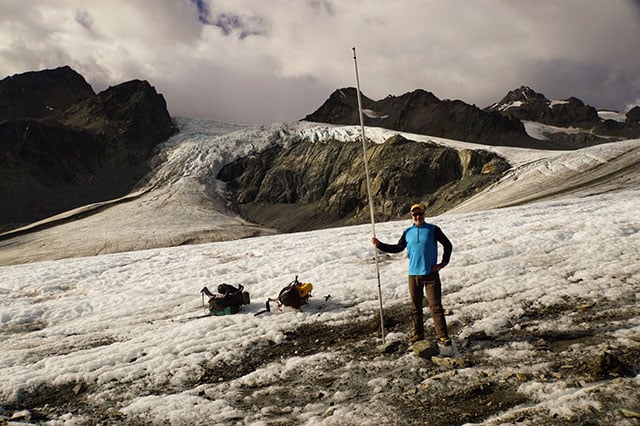 The author holds a glacier survey stake on Alaska’s Gulkana Glacier. The stake was placed in April, at which time the tip of the stake was just inches below the surface of the snowpack. The snowpack is gone, along with roughly three feet of glacial ice. (Photo: Louis Sass)
The author holds a glacier survey stake on Alaska’s Gulkana Glacier. The stake was placed in April, at which time the tip of the stake was just inches below the surface of the snowpack. The snowpack is gone, along with roughly three feet of glacial ice. (Photo: Louis Sass)
The most detailed study to date shows that Arctic sea ice-melt over the last 20 years is “unprecedented” and “enormously outside the bounds of natural variability.” Julienne Stroeve with the US National Snow and Ice Data Center said that the Arctic sea ice has not been at levels as low as it is today for at least 5,000 to 7,000 years. Stroeve noted, “Some other studies have suggested at least 800,000 years.”
“Next year or the year after, the Arctic will be free of ice,” Dr. Peter Wadhams, who has spent his entire scientific career involved in dozens of trips to study the Arctic, told The Guardian recently. Wadhams, who was one of the very first scientists to warn that the thick Arctic icecap was beginning to thin, directed the Scott Polar Institute in Cambridge from 1987 to 1992, and has been a professor of ocean physics at Cambridge since 2001.
Meanwhile, capitalizing on the disaster afflicting the Arctic (and the planet), a luxury cruise ship set sail from Seward, Alaska in late August en route to New York, via the Arctic. Upwards of 1,700 passengers and crew are, as you read this, riding aboard the “Crystal Serenity,” with passengers paying from $22,000 per person for the trip, with some paying in the six-figure range. Those prices do not include helicopter rides or excursions onto the melting Greenland Ice Sheet, which will also be offered. The ship that is making its way through the fragile Arctic is 820 feet long with 13 decks, 535 staterooms, multiple swimming pools, a movie theater, a driving range and putting green, a casino, a spa, fitness center, hair salon and 24-hour room service.
The boat sold out quickly, and the company is already well into the planning of a second journey.
The tropics aren’t faring any better than the Arctic, in the climate department.
A recent report showed that the carbon pledges made by 178 countries in Paris last December won’t be nearly enough to save most tropical coral reefs and cloud forests, let alone preventing mass global extinctions.
Every day now brings us further into uncharted territory.
Earth
A recent study published in Scientific Reports showed that ACD is going to cause beaches to become saltier, which will likely lead to significant changes for birds, crabs and other creatures living on coasts.
Shocking news recently emerged from India, where over a quarter of that country’s land is turning into desert thanks largely to ACD, according to a recently published study.
In the Western US, the American pika is vanishing across many mountain areas due to ACD, altering the habitat of the rabbit-like mammal according to recently released USGS findings. For example, in northeastern California, pikas were only found in 11 of 29 sites where they once lived.
In Scotland, a conservation group recently announced that rare mountain plants in the Scottish highlands are disappearing at an “alarming rate” and facing possible extinction due to ACD.
Back in Alaska, the city of Shishmaref — which is located on an island that is being rapidly eroded by rising seas, melting permafrost and intensified storms — has voted to relocate due to ACD. There are at least 31 other Alaskan Native villages threatened by ACD, which will eventually have to relocate as well.
Alaska, which has never had dog ticks before, is now threatened with exotic ticks, which have recently begun to establish themselves in the state. While researchers acknowledge that some of the ticks likely hitchhiked on dogs and humans, many of them did not. One variety, the American dog tick, transmits the bacterium that causes Rocky Mountain spotted fever. It can also secrete a toxin that causes tick paralysis, which can be fatal in both dogs and humans, according to the researchers.
Water
The massive “blob” of overheated water in the Eastern Pacific that has been afflicting marine life along the US West Coast and Alaska for the last several years, persists. It has now become just another example of a growing global phenomenon of oceanic “heat waves.” One has been impacting Australia recently as well.
Off the coast of Australia, the Great Barrier Reef recently experienced a massive coral bleaching event that killed off more than one-fifth of the reef.
Another recent report showed that ocean slime, composed of toxic algae blooms, is rapidly spreading across Earth as a result of warming ocean waters. The toxic algae is worsening dead zones and wiping out parts of the food chain for marine life, causing collapsing populations of sea lions, seals, various bird species and fish around the planet.
Meanwhile in the Arctic, fish populations are shifting rapidly as the sea ice dwindles. According to a recent report from the USGS and the US Bureau of Ocean Energy Management (BOEM), at least 20 different species have now found their way into Arctic waters that had previously never been found there. Additionally, another 63 species have changed their ranges from what they used to be.
A recent study also showed that the Greenland Ice Sheet continues to melt extremely rapidly, losing the equivalent of 110 million Olympic-size swimming pools worth of water each year. In other words, 270 gigatons of ice have melted per year from 2011 to 2014. The study also showed that the melting in Greenland is continuing to accelerate with time.
Down in the Antarctic, a recent report showed that a massive rift is growing across the fragile Larsen C Ice Shelf. As the crack continues to spread at an accelerating rate, it threatens to release an iceberg the size of Delaware. More importantly, it will eventually destabilize an even larger area of ice, roughly the size of Scotland.
Back in the continental US, a massive fish kill in Yellowstone National Park caused authorities to close off a 183-mile portion of the river and its tributaries. The parasite that caused the die-off was helped along by the ACD-warmed river water.
Lastly, as the planet continues to warm and Canada experiences less and less snowfall, the country’s ski resorts are attempting to “weatherproof” themselves from the impacts of ACD. This means they will be offering other things to do aside from skiing and snowboarding in the winter — such as mountain biking, eco-tours and Iron Man competitions. Earlier this year, British Columbia’s world-renowned Whistler Blackcomb resort announced a $345 million plan to become “weather independent,” whatever that means.
Fire
Given that much of the Northern Hemisphere is in the warmest portion of summer of the hottest year on record (thus far), it should not come as a surprise that there is a preponderance of major wildfires.
In the US, record temperatures and an ongoing five-year-long drought across most of California caused one fire to burn well over 30,000 acres, forcing more than 82,000 people to evacuate.
More than 170 square miles, and counting, have been burned across California during this wildfire season alone.
A recently published study shows that both California’s wildfire season and its air quality will be getting worse with time. The study outlines the obvious: Warmer temperatures and drought across California are expected to continue, hence setting the stage for more and larger wildfires, which will bring far more smoke, ash and particulate.
Furthermore, according to the US Forest Service, there are at least 66 million dead trees located across 760,000 acres in the Southern Sierra Nevada, which are essentially a massive wildfire waiting to happen.
Air
NASA’s top climate scientist, Gavin Schmidt, who directs the Goddard Institute for Space Studies, recently said that Earth is warming at a pace not seen for at least the past 1,000 years, which means it is “very unlikely” that global temperatures will stay below the 1.5C limit agreed to in Paris. “In the last 30 years, we’ve really moved into exceptional territory,” Schmidt told the Guardian US. “It’s unprecedented in 1,000 years.”
“Maintaining temperatures below the 1.5C guardrail requires significant and very rapid cuts in carbon dioxide emissions or coordinated geoengineering,” he added. “That is very unlikely. We are not even yet making emissions cuts commensurate with keeping warming below 2C.”
While it has been discussed before, an international team of researchers recently stated that Earth has now been pushed into the Anthropocene epoch, due to ACD, the spread of plastics, and new metals and concrete. This is the first new geological epoch for the Earth in more than 11,500 years, and it is due to the intensely rapid industrialization of the planet over the course of the last century.
Denial and Reality
Willful ACD denial, while still alive and well in the fossil-fuel-funded political corridors of the US federal government, is currently taking a serious (and much-needed) attack.
A recently released report by the environmental advocacy group Climate Investigations Center showed that at least 18 major companies have departed from the two primary coal lobbying groups, the National Mining Association and the American Coalition for Clean Coal Electricity, since 2009. Some of those leaving are doing so because of the lobbying groups’ so-called climate science.
Other significant strides are being made on the reality front.
Across the Atlantic, The Netherlands could become the first country in the world to ban gas- and diesel-powered vehicles by 2025 if members of the Dutch Labour Party get their way. These politicians have put forth their proposal.
“We need to phase out CO2 emissions and we need to change our pattern of using fossil fuels if we want to save the Earth,” John Vos, a member of the Dutch Labour Party, told the Yale Climate Connection.
National Public Radio recently ran a story addressing the issue of overpopulation. The story features Travis Rieder, a philosopher with the Berman Institute of Bioethics at Johns Hopkins University, who is visiting classrooms in order to encourage students to consider the ramifications of population growth during runaway ACD.
Considering the fact that there will be 240,000 people at the dinner table tonight who weren’t there last night, and that we are adding the equivalent of a city the size of Houston to the planet every month, and a country the size of Egypt every year, Rieder is giving folks something to consider.
Meanwhile, another recently published study showed that anthropogenic greenhouse gases began to increase the Earth’s temperatures nearly two centuries ago when the Industrial Revolution began to pick up steam, thus challenging the widely held notion that ACD only began in the 20th century.
Another reality check came recently in the form of a striking piece in the Guardian, which outlined how national parks across the US are being utterly hammered by ACD.
“An NPS [National Park Service] study from 2014 found four in five of America’s national parks are now at the ‘extreme end’ of temperature variables charted since 1901,” the article reads. It goes on to quote Gregor Schuurman, an ecologist at the NPS climate change response program: “We are starting to see things spiral away now…. We are going to look back at this time and actually think it was a calm period. And then people will start asking questions about what we were doing about the situation.”
The article draws attention to several stark realities, including the fact that since 1968, the number of glaciers at Glacier National Park has fallen by half. Researchers predict that by the middle of the 21st century, if conditions remain similar, all of the park’s glaciers will be gone.
What will Glacier National Park be called when all of its glaciers have disappeared?
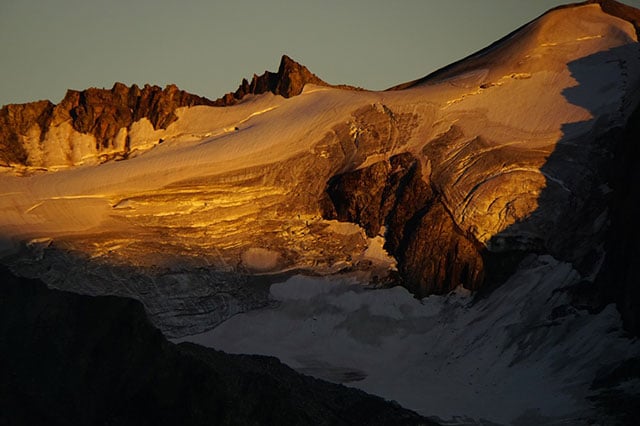 Sunset above the Gulkana Glacier, which, along with nearby pocket glaciers, is melting and receding abruptly. (Photo: Dahr Jamail)
Sunset above the Gulkana Glacier, which, along with nearby pocket glaciers, is melting and receding abruptly. (Photo: Dahr Jamail)
Lastly, a recent report warned that we are already locked into far more planetary warming than most folks realize. Given that humans continue to inject over 30 billion tons of CO2 into the atmosphere annually, and the fact that what is already there has us locked into (conservatively) another 1.5-3C of warming in the coming decades, the new climate reality is upon us.
After spending a summer traversing much of Alaska while doing climate disruption research, I know that Alaska is no longer the Alaska of American folklore. It’s also no longer the Alaska I knew 20 years ago. The glaciers are melting and receding at record paces, and the long, frigidly cold winters are no longer nearly as cold as they once were.
Alaska, along with the rest of the Arctic, is truly the canary in the proverbial coal mine. It is sending us a clear message: We are already living in a new world — a world definitively shaped by anthropogenic climate disruption.
Media that fights fascism
Truthout is funded almost entirely by readers — that’s why we can speak truth to power and cut against the mainstream narrative. But independent journalists at Truthout face mounting political repression under Trump.
We rely on your support to survive McCarthyist censorship. Please make a tax-deductible one-time or monthly donation.